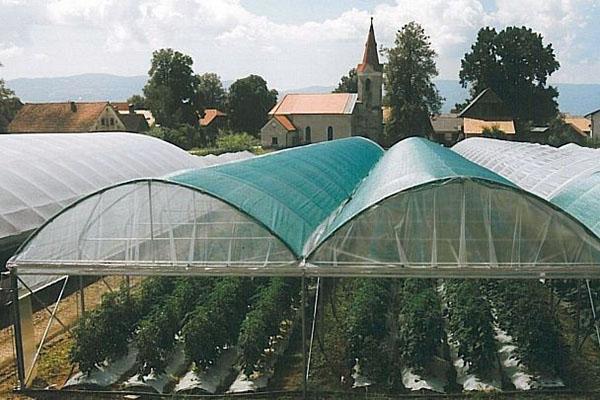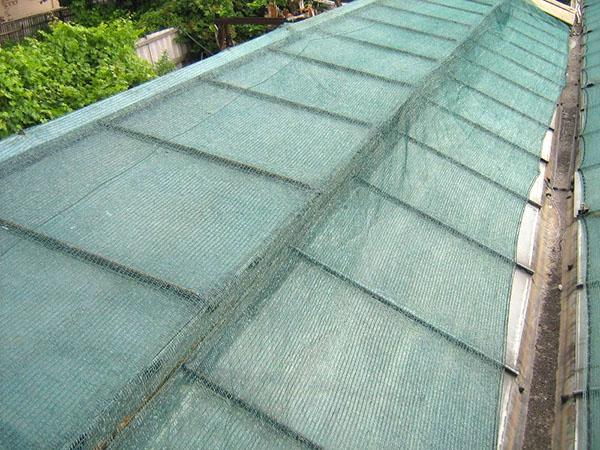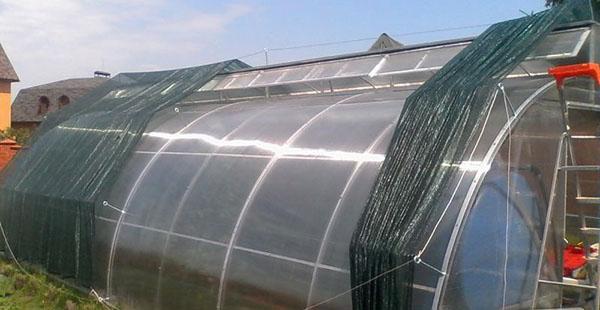What is the best shading mesh for greenhouses and how to choose
 Greenhouse shading net is an effective means of protecting plants from excess sunlight. A greenhouse organization with shading provides protection against temperature extremes and maintains the required level of humidity. As a result, the productivity of the planted plants increases and the yield is preserved.
Greenhouse shading net is an effective means of protecting plants from excess sunlight. A greenhouse organization with shading provides protection against temperature extremes and maintains the required level of humidity. As a result, the productivity of the planted plants increases and the yield is preserved.
Appointment of shading mesh for greenhouses

The action of such protection is based on the following principles:
- partial reflection of bright sunlight;
- reduction of thermal radiation;
- preservation of moisture in the soil;
- increased photosynthesis;
- uniform illumination of the entire greenhouse area;
- scattering of radiation falling on plants.
The use of nets creates favorable conditions for the growth and development of plants with uniform light diffusion. The yield of crops grown in greenhouse farms depends largely on the presence of a shading grid. For example, for a tomato, this figure becomes 20% higher.
In addition to directly shading greenhouses, nets can be used to cover gazebos, sheds, cars and for other purposes.
Main types
 To answer the question of how to choose a shading mesh, you need to familiarize yourself with the existing types of these products. This addition to the design of greenhouses allows not only to reduce the intensity of sunlight, but also to better retain heat (up to 20%). This is especially important when there are significant differences between day and night air temperatures.
To answer the question of how to choose a shading mesh, you need to familiarize yourself with the existing types of these products. This addition to the design of greenhouses allows not only to reduce the intensity of sunlight, but also to better retain heat (up to 20%). This is especially important when there are significant differences between day and night air temperatures.
The main indicators of shading nets for greenhouses:
- shading degree;
- material;
- color.
Density: more is not always better
 Depending on the climatic zone and the characteristics of the particular crop grown, the type of material is selected. For outdoor use, 70% shading is suitable. 60% - for shading from extreme heat when growing cabbage, lettuce, eggplant, greens, tomatoes. 45% is a sufficient degree of shading for light-loving crops such as cucumbers.
Depending on the climatic zone and the characteristics of the particular crop grown, the type of material is selected. For outdoor use, 70% shading is suitable. 60% - for shading from extreme heat when growing cabbage, lettuce, eggplant, greens, tomatoes. 45% is a sufficient degree of shading for light-loving crops such as cucumbers.
A shading degree higher than 70% is not used for covering greenhouses.
Manufacturing material: possible options

The following materials are used for the production of meshes:
- the cloth;
- polymers;
- polycarbonate.
|
Material making
|
Characteristic |
|
the cloth | Simple and cheap material that has a short service life. Not recommended for greenhouse shading. |
| Polycarbonate | Durable material that is resistant to external weathering. Has a long service life. |
|
Polymer | Has a low cost and low density. Recommended for shading from the sun, protecting against pests and gusts of wind. |
Mesh color: what depends on the shade
 Greenhouse shading nets can be of different colors. This circumstance affects the spectrum of transmitted sunlight. Light waves reaching the plant can change the life cycle of the plant.
Greenhouse shading nets can be of different colors. This circumstance affects the spectrum of transmitted sunlight. Light waves reaching the plant can change the life cycle of the plant.
The color of the greenhouse shade net can delay or accelerate maturation up to 1.5-2 weeks.
 The process of growth, flowering and ripening is accelerated by the red color, and slowed down by the dark ones: blue, black and gray.In this case, it is necessary to take into account the effect of color on a particular agricultural crop.
The process of growth, flowering and ripening is accelerated by the red color, and slowed down by the dark ones: blue, black and gray.In this case, it is necessary to take into account the effect of color on a particular agricultural crop.
|
P / p No.
|
Mesh color |
Influence of color |
Note |
| | Gray and gray-green |
| Does not affect yield |
| | Blue |
|
— |
| | Pearl |
|
— |
| | Red |
|
— |
| | Blue green |
| Suitable for year-round greenhouses |
Setting the grid
 How to attach the shading mesh is determined by the way the fasteners are made and the materials used. The synthetic shading material is lightweight, which makes it easy to install, without involving a large number of people. Fastening is carried out using supports and clips.
How to attach the shading mesh is determined by the way the fasteners are made and the materials used. The synthetic shading material is lightweight, which makes it easy to install, without involving a large number of people. Fastening is carried out using supports and clips.
For the convenience of fastening, holes are used that are located at the edges of the mesh material.
Supporting structures can be metal or wood. These can be elements of the frame of the greenhouse itself, fence posts... Well-fixed mesh is resistant to wind gusts and bad weather. It can also be installed in greenhouses with an opening dome.
In this case, the grid will be:
- shade from sunlight;
- serve as protection from wind and hail;
- let rain water pass.
If necessary, the mesh canvases can be stitched together, fastened with plastic ties or cables to the pipes. Fastening to wooden structural elements can be carried out even with a construction stapler.
For very large farm greenhouses it is recommended to use automatic shading control.
5 recommendations for choosing

In order to correctly choose the shading, it is advisable to pay attention to the following expert advice:
- The larger the mesh, the more sunlight the mesh will let through.
- Polycarbonate and polymer meshes are preferable to fabric.
- If a versatile shading option is required, it is recommended to choose a blue-green material color.
- A quality product will last longer than a cheap one.
- Before purchasing a mesh, preliminary measurements must be taken.
 The affordable cost of nets and their large assortment contribute to the massive use of this type of shading for greenhouses. The use of a shading mesh is a contribution to the future harvest.
The affordable cost of nets and their large assortment contribute to the massive use of this type of shading for greenhouses. The use of a shading mesh is a contribution to the future harvest.